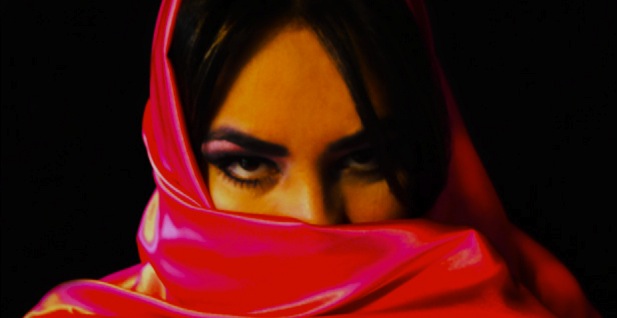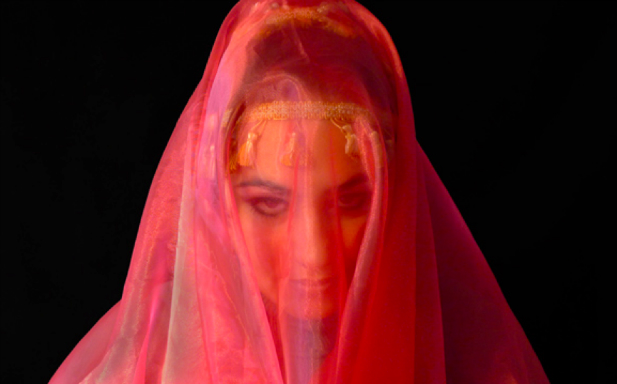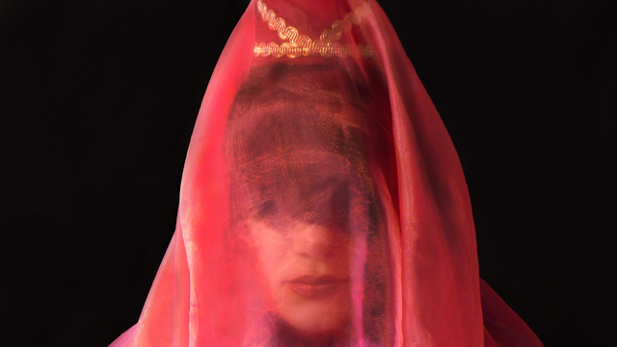I Dream of Jeannie
IRANIAN-AMERICAN ARTIST ERIC PARNES’ SOLO EXHIBITION AT THE KATARA CULTURAL VILLAGE

The phenomenon of Orientalism is traditionally defined by most art scholars as the recurrent Western practice of appropriating or reinventing Eastern imagery in their own art and literature. Perhaps standard art history’s most disseminated, and conspicuous, use of this approach is seen in 19th century Academic painting, wherein a significant number of artists were fascinated with depicting their own revisions of the mystical exotica of what they saw as the extrinsic, untouchable Middle East. The captivating region’s traditional resplendent wardrobes amidst a backdrop of sandy cities, inhabiting clusters of majestic architecture, set the perfect tone of another flavor of alluring romanticism desperately sought in their time. However - what we know today as pop culture, which includes the development of ideas commonly referred to as Americana, or even kitsch - also frequently inherits from this Orient in what can seemingly only be referred to as Neo-Orientalism.
Perhaps no other known artist so poignantly introduces the contemporary cultural term of Neo-Orientalism than Eric Parnes, whose work effectively conveys a revealing examination of the experience as it can be felt today - not yesterday, not tomorrow - but in the very literal now. The artist’s distinct approach, as seen in all his work to date, comes across as relevant, fresh, and strikingly meaningful; and, no matter what subject matter thus far the artist has tackled, the denouement each time remains aesthetically interesting with a personal signature idiosyncrasy. His work appears to philosophically salvage from both the old and the new, emerging with valuable elements of classical Persia and from astute representations of the 21st century Middle East. Intermittently incorporating visual souvenirs of the greater Babylonian empire, the art of Eric Parnes also converges with articulate contemporary symbols of the ever-developing modern-day Orient as it continues to ubiquitously influence our intensely globalizing and immersive world culture.
In the exhibition of Parnes’ pieces assembled for I Dream of Jeannie / I See Demons, the artist touches upon a Neo-Orientalist phenomena of late 1960’s Americana, that generated a remarkably powerful influence of aesthetic and musical fantasy still resonating to this day: the creation of a hit romantic comedy television series entitled I Dream of Jeannie. Starring actress Barbara Eden in the title role of a female genie, the show aired for an entire five seasons from September 1965 to May 1970, first produced in black & white and, later, in color. It is of interest that the show’s premise was conceived of in the time following the much-publicized official visit of the Shah of Iran to the United States during the Kennedy Administration. The show’s concept creator, and writer of its pilot episode The Lady In The Bottle, Sidney Sheldon, later reminisced that the idea for Jeannie was partly inspired by the 1964 film The Brass Bottle, a cinematic production which had starred famed actor Tony Randall as well as the aforementioned Ms. Eden, along with musical artist Burl Ives portraying a friendly genie named Fakrash. However, it was Sheldon’s complete metamorphosis, of a new vision of a genie played by a blonde, blue-eyed female - a role now given to Barbara Eden - that fiercely propelled I Dream of Jeannie’s reinvention of ancient Persian mysticism into the Western psyche and forever influenced the cultural landscape.
‘The TV show then entered the mainstream vernacular of the typical American and still maintains its influence’, reflects the artist Eric Parnes. ‘This example of Neo-Orientalism not only retains its poignancy, but it is even more relevant today’.
From the start, the lead female character of I Dream of Jeannie begins speaking in Persian, although Sheldon’s original script appears to state that her lines are to be read in an ‘Arabic’ language, showcasing Hollywood’s confusing goulash of attempting to portray the exotic allure of Orientalism and the Middle East. At the same time, the choice of language is interestingly accurate, as the backdrop story of the One Thousand and One Nights (commonly known in the West as the Arabian Nights), as well as many of the tales themselves take place in, and have their roots in Sasanid Persia. As the television show proceeded, Jeannie later began to exclusively speak in English, with rare exceptions.

In the show, astronaut Captain Tony Nelson (played by Larry Hagman) abandons a malfunctioning spaceship shortly after lift-off and crashes somewhere between India and Australia. Finding himself on a deserted Island Beach, he decides to write an S.O.S. on the sands (seaman’s code for ‘Save Our Ship’) in the hope he will be noticed and rescued. While doing so, he finds an ornate green vial to complete the final S in the distress signal. Accidentally rubbing the bottle, smoke emerges and the beautiful blonde genie Jeannie appears, declaring in Persian, Bandeh be goosh-e farman-e to hastam, sardar (your wish is my command, Master).
‘My heart sings at having such a handsome master’, she says to the stunned Captain Nelson, ‘I am yours to command … Sheklat mesleh seema-ye yek khalifeh hast (‘you have the face of a wise and fearless Caliph,’ according to Sheldon’s pilot script). ‘I must have gone further into orbit,’ the bewildered astronaut declares. ‘I’ve read about genies … it’s like something out of Arabian Nights’.
She does not adapt immediately to the leading man’s English, further exclaiming in Persian, ‘You speak in a strange tongue’. Yet, ‘I am fortunate to have you as my Master,’ she declares, adoringly.
Parnes points out that the name of the television show itself, I Dream of Jeannie, is a play on the French word genie, a derivative emerging directly from the Arabic word Jinn (a supernatural being mentioned in the Holy Koran). The Western concepts of the genie usually range from the wondrously benign to the downright mischievous. Yet, in the Middle East, the Jinn is reportedly most often identified as having negative intentions of mischief-making and trouble-doing. In fact, the artist further states that when translating the show’s famous American title into Persian, it translates - quite literally - as I See Demons.
Accidentally rubbing the bottle, smoke emerges and the beautiful blonde genie Jeannie appears, declaring in Persian, Bandeh be goosh-e farman-e to hastam, sardar
It has been almost half a century since the show’s television debut. Nonetheless, the masses continue to be pulled to the hypnotic allure of Jeannie, as references to the character and show constantly emerge across the spectrum of modern and contemporary pop culture. It is still commonly referenced in various other television shows ranging from the long-running soap opera As The World Turns, to Seth McFarlane’s iconic satire Family Guy, to HBO’s gritty series The Sopranos (featuring the episode I Dream of Jeannie Cusamano). Even older television series, from the same era as the original I Dream of Jeannie, often featured references and inspirations of the female genie, such as the popular show by the mock-Beatles band The Monkees, who once portrayed a Jeannie look-alike who appeared after group bandmate Davy Jones rubbed a lamp. American pop vocalist Christina Aguiliera’s hit 1999 single Genie In A Bottle, which quickly established her as a leading musical artist, is also clearly inspired by the original television show’s heroine. Today, a wide array of pop culture personalities, such as heiress and TV personality Paris Hilton as well as musical curiosity Lady Gaga, have dressed in homage to Jeannie, and children’s contemporary toys and costumes are still replete with references to the series. One can even occasionally find masses of women dressed as Jeannie, running themed marathons or parading in costumed marches in various American cities.
The publication of recent memoirs written by the show’s leading lady Barbara Eden - just released last year - was a New York Times Bestseller, further confirming the wide and strong public interest in the undying enigma of Jeannie.
It is of especial interest to note that Jeannie’s famous bottle was not specifically manufactured for the show. The actual bottle was a 1964 Jim Beam Bourbon Whiskey liquor decanter, produced as a specialty release for Christmas that year. It was created by a commercial designer by the name of Roy Kramer for the Wheaton Bottle Company, clearly influenced by a Middle Eastern design. Reportedly, Jim Beam Distillery’s President at the time, Martin Lewin, had travelled through Europe to inspect the company’s branches situated overseas; and during a trip to Germany in 1963, he spotted a Middle Eastern decanter that would eventually become the holiday edition of the whiskey and later the vessel for Jeannie.
Aside from its usage in the television show, as Eric Parnes notes, the bottle’s manufactured intention to specifically serve as Haraam (lit. sinful/forbidden in Arabic), serves another controversially menacing dichotomy in itself. Reproduced by the artist in porcelain, utilizing a select choice of single colors, the bottle becomes a symbolic fine art sculpture and finds newfound meaning in the exhibition’s piercing dual title.

The selection of works in this exhibition examines the broader implications of the dynamics between the East and the West
In the compelling argument that contemporary art has replaced the role of new philosophy in today’s society, we now may find that reflective imagery, in all sorts of mediums not only limited to painting and sculpture, can teach us much about understanding our past as well as the present state of our human condition. Parnes’ aesthetic contribution to the latest evolution of the Jeannie vessel makes the sculpture one of the strongest expressions of Orientalism, in the bottle’s overall journey in the West to its current reincarnation as a work of stirring symbolism in contemporary fine art. ‘The selection of works in this exhibition examines the broader implications of the dynamics between the East and the West, as based in this program,’ remarks the artist.
Here, Parnes’ engaging photographs of Middle Eastern women adorned with an unexpectedly pink headpiece reminiscent of the Jeannie character, with matching pink scarves, subtly comment on the underlying clash of fiction and reality we face everyday as a virtue of the human experience. Some women wear more contemporary versions of a pink veil as a customary hijab, or simply as a scarf. The works in the set individually serve as a testament to Western imagination meeting the colloquial actualities of the palpable Middle Eastern regions.
Another piece further explores the coexistence of fantasy and reality. In a fine art installation sculptural piece, which utilises the familiar image of a doll, Parnes appears to hint what an actual Jinn may look like using the common fashion senses of the contemporary Middle East, instead of mimicking the I Dream of Jeannie character. The Jinn is beautiful and inviting, yet at the same time, exerts a certain sense of possible vexatious danger.
Two large scale paintings, intentionally executed in acrylic, further magically merge with the theme of the Persian expression of visions of jinn. The seductive gaze of its subject pulls us into the enchanting mystery of a beckoning genie inviting us into an unknown world of possibility. The paintings’ excellent imagery captures this absorbing, intangible spirit as a phylactery of sorts.
Together, the group of works seen in the exhibition I Dream of Jeannie / I See Demons collectively showcase an artist’s meaningful examination of Neo-Orientalism in recent history, and how this particular television phenomena has unexpectedly cast a powerful, enduring spell that continues to affect the world’s imagination of the East. Similar to the mystical character Jeannie having been released after 2,000 years in a bottle by a modern astronaut, as a contemporary visionary explorer Eric Parnes takes us with him on a fascinating journey to reopen the magical in our own present time.
I Dream of Jeannie / I See Demons will be on view at the Katara Cultural Village in Doha, Qatar between October 23 and November 24, 2012.
Comments
Powered by Facebook Comments





